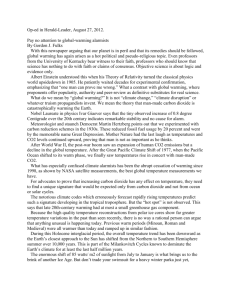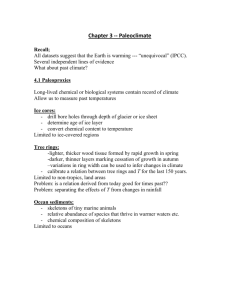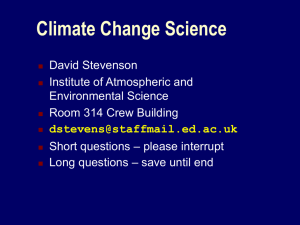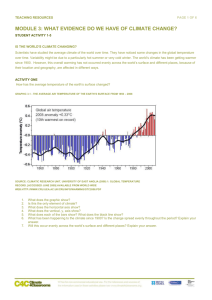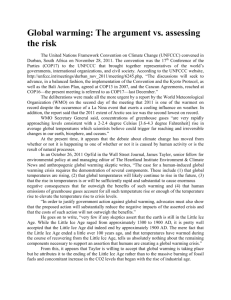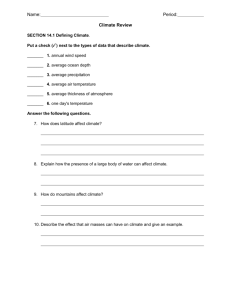File
advertisement
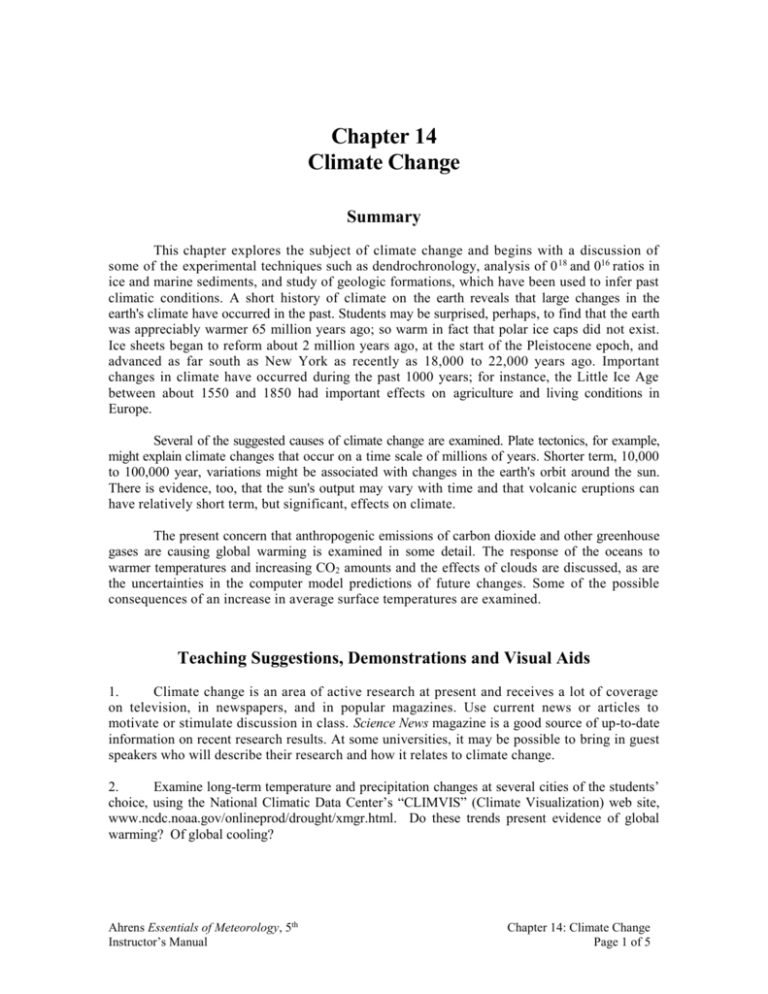
Chapter 14 Climate Change Summary This chapter explores the subject of climate change and begins with a discussion of some of the experimental techniques such as dendrochronology, analysis of 0 18 and 016 ratios in ice and marine sediments, and study of geologic formations, which have been used to infer past climatic conditions. A short history of climate on the earth reveals that large changes in the earth's climate have occurred in the past. Students may be surprised, perhaps, to find that the earth was appreciably warmer 65 million years ago; so warm in fact that polar ice caps did not exist. Ice sheets began to reform about 2 million years ago, at the start of the Pleistocene epoch, and advanced as far south as New York as recently as 18,000 to 22,000 years ago. Important changes in climate have occurred during the past 1000 years; for instance, the Little Ice Age between about 1550 and 1850 had important effects on agriculture and living conditions in Europe. Several of the suggested causes of climate change are examined. Plate tectonics, for example, might explain climate changes that occur on a time scale of millions of years. Shorter term, 10,000 to 100,000 year, variations might be associated with changes in the earth's orbit around the sun. There is evidence, too, that the sun's output may vary with time and that volcanic eruptions can have relatively short term, but significant, effects on climate. The present concern that anthropogenic emissions of carbon dioxide and other greenhouse gases are causing global warming is examined in some detail. The response of the oceans to warmer temperatures and increasing CO2 amounts and the effects of clouds are discussed, as are the uncertainties in the computer model predictions of future changes. Some of the possible consequences of an increase in average surface temperatures are examined. Teaching Suggestions, Demonstrations and Visual Aids 1. Climate change is an area of active research at present and receives a lot of coverage on television, in newspapers, and in popular magazines. Use current news or articles to motivate or stimulate discussion in class. Science News magazine is a good source of up-to-date information on recent research results. At some universities, it may be possible to bring in guest speakers who will describe their research and how it relates to climate change. 2. Examine long-term temperature and precipitation changes at several cities of the students’ choice, using the National Climatic Data Center’s “CLIMVIS” (Climate Visualization) web site, www.ncdc.noaa.gov/onlineprod/drought/xmgr.html. Do these trends present evidence of global warming? Of global cooling? Ahrens Essentials of Meteorology, 5th Instructor’s Manual Chapter 14: Climate Change Page 1 of 5 Student Projects 1. Have students obtain climatological data (mean temperature and precipitation amounts), from their city or a city nearby, for as long a period of time as possible. Are there any noticeable periodic variations or long-term trends? Can any observed fluctuations be correlated with recent volcanic eruptions, strong ENSO events, or the sunspot cycle? Where were the weather data obtained? Has urbanization had any effect on the weather data? It might be possible to obtain a section from a recently cut tree. Then, if a date can be accurately identified with one of the growth rings, try to determine whether the width of the rings is correlated with past mean annual temperatures or yearly rainfall amounts. 2. Using a book that describes the local geology, have the students prepare a report on the past climate in their region. If possible, photograph or obtain samples from geological structures that were used to infer past conditions. 3. Use the Temperature Trends section of the ThomsonNow web site to examine estimates of future global temperatures. According to these model projections, is the term “Global Warming” appropriate? Which areas of the globe are projected to warm the most? Are there any areas that are expected to cool? 4. Using the Forecasting section of the ThomsonNow web site, examine the relationship between current temperatures and cloud cover. Describe any relationship you observe. Using this observation, comment on the possible effects that future changes in cloud cover might have on future temperature changes. Answers to Questions for Review 1. The study of the geological evidence left behind by advancing and retreating glaciers; collection of fossil pollen of tundra plants; core samples taken from ocean floor sediments and Greenland and Antarctica ice; the study of annual growth rings of trees; documents concerning droughts, floods, and crop yields; the study of oxygen-isotope ratios of corals; borehole temperature profiles. 2. The most recent North American glaciers reached their maximum thickness and extent about 18,000 to 22,000 years ago. At that time, the sea level was perhaps 120 m (395 ft) lower than it is now. The lower sea level exposed vast areas of land, such as the Bering land bridge, a strip of land that connected Siberia to Alaska, which allowed human and animal migration from Asia to North America. 3. It is significantly higher. 4. The Younger-Dryas was a cold spell lasting from about 12,700 to 11,700 years ago. 5. A positive feedback mechanism is a process which is reinforced by other processes. A negative feedback mechanism is a process which is weakened by interactions among other variables. The water vapor-temperature increase process is a positive feedback mechanism. Ahrens Essentials of Meteorology, 5th Instructor’s Manual Chapter 14: Climate Change Page 2 of 5 6. According to plate tectonics, the now existing continents were at one time joined together in a single huge continent, which broke apart. Its pieces slowly moved across the face of the earth, thus changing the distribution of continents and ocean basins. We find glacial features near sea level in Africa today, suggesting that the area underwent a period of glaciation hundreds of millions of years ago. Were temperatures at low elevations near the equator ever cold enough to produce ice sheets? Probably not. The ice sheets formed when this land mass was located at a much higher latitude. Over the many millions of years since then, the land has slowly moved to its present position. Along the same line, we can see how the fossil remains of tropical vegetation can be found under layers of ice in polar regions today. 7. The first cycle deals with changes in the shape (eccentricity) of the earth’s orbit as the earth revolves about the sun. To go from less elliptical to more elliptical and back again takes about 100,000 years. The greater the eccentricity of the orbit (that is, the more eccentric the orbit), the greater the variation in solar energy received by the earth between its closest and farthest approach to the sun. The second cycle takes into account the fact that, as the earth rotates on its axis, it wobbles like a spinning top. This wobble, known as the precession of the earth’s axis, occurs in a cycle of about 23,000 years. This affects the strength of seasonal variations in climate. The third cycle takes about 41,000 years to complete and relates to the changes in tilt (obliquity) of the earth as it orbits the sun. Presently, the earth’s orbital tilt is 23.5∞, but during the 41,000-year cycle the tilt varies from about 22∞ to 24.5∞. The smaller the tilt, the less seasonal variation there is between summer and winter in middle and high latitudes. Thus, winters tend to be milder and summers cooler. During the warmer winters, more snow would probably fall in polar regions due to the air’s increased capacity for water vapor. And during the cooler summers, less snow would melt. As a consequence, the periods of smaller tilt would tend to promote the formation of glaciers in high latitudes. 8. Lower. 9. Sulfate aerosols reflect incoming sunlight, which tends to lower the earth’s surface temperature during the day. Sulfate aerosols may also modify clouds by increasing their reflectivity. 10. They tend to cool the surface, because the particles are vary small and are injected to high altitudes where they quickly encircle the globe and scatter large amounts of sunlight. 11. Sunspots, huge magnetic storms on the sun, occur in cycles, with the number and size reaching a maximum approximately every 11 years. During periods of maximum sunspots, the sun emits more energy (about 0.1 percent more) than during periods of sunspot minimums Evidently, the greater number of bright areas (faculae) around the sunspots radiate more energy, which offsets the effect of the dark spots. Some researchers argue that periodic 20-year droughts on the Great Plains of the United States seem to correlate with the 22-year cycle in the sun's magnetic output. 12. Water vapor. 13. The yellow line represents projected temperature increases due to the effects of greenhouse gases alone, ignoring the effects of aerosols and changes in solar radiation. The grey line (actual temperatures) responds to all of these processes. Ahrens Essentials of Meteorology, 5th Instructor’s Manual Chapter 14: Climate Change Page 3 of 5 14. Water vapor, via the water vapor-greenhouse effect feedback; solar irradiance changes; volcanic eruptions rich in sulfur. 15. a. Clouds reflect incoming sunlight back to space, a process that tends to cool the climate, but they also absorb infrared radiation from the earth, which tends to warm it. b. High clouds promote warming, low clouds promote cooling. 16. From about 1900 to 1945, the average temperature rose nearly 0.5°C. Following the warmer period, the earth began to cool slightly over the next 25 years or so. In the late 1960s and 1970s, the cooling trend ended over most of the Northern Hemisphere. In the mid-1970s, a warming trend set in that continued into the twenty-first century. It appears, in fact, that over the Northern Hemisphere, the decade of the 1990s was the warmest of the 20th century, with 1998 and 2005 being the warmest years in over 1000 years. 17. The conveyor-like circulation begins in the north Atlantic near Greenland and Iceland, where salty surface water is cooled through contact with cold Arctic air masses. The cold, dense water sinks and flows southward through the deep Atlantic Ocean, around Africa, and into the Indian and Pacific Oceans. In the North Atlantic, the sinking of cold water draws warm water northward from lower latitudes. As this water flows northward, evaporation increases the water’s salinity (dissolved salt content) and density. When this salty, dense water reaches the far regions of the North Atlantic, it gradually sinks to great depths. This warm part of the conveyor delivers an incredible amount of tropical heat to the northern Atlantic. During the winter, this heat is transferred to the overlying atmosphere, and evaporation moistens the air. Strong westerly winds then carry this warmth and moisture into northern and western Europe, where it causes winters to be much warmer and wetter than one would normally expect for this latitude. 18. Because evidence from climate models and past temperature histories support the idea that the recent warming is largely due to greenhouse gases. 19. Climate models predict that land areas will warm more rapidly than the global average, particularly in the northern high latitudes in winter. If warming allows the boreal forests to expand into the tundra, the forests may accelerate the warming in that region. As the temperature rises, organic matter in the soil should decompose at a faster rate, adding more CO2 to the air, which might accelerate the warming even more. In a warmer world, enhanced evaporation of water should lead to greater worldwide average precipitation. Some models predict that the jet stream will weaken and global winds will shift from their “normal” position. The shifting upper-level winds might reduce precipitation over certain areas, which, in turn, would put added stress on certain agricultural regions. 20. The other important greenhouse gases are methane, nitric oxide, halocarbons and ozone. Answers to Questions for Thought and Exploration 1. The chemical concentrations retrieved from the water and air bubbles within ice cores may have undergone a variety post-depositional processes which can complicate their interpretation. These processes include chemical reactions, blowing and drifting, wind pumping (horizontal movement within Ahrens Essentials of Meteorology, 5th Instructor’s Manual Chapter 14: Climate Change Page 4 of 5 the snowpack), freezing and thawing, and folding associated with subsurface glacial movement. 2. Because of the lower temperatures (in the Northern Hemisphere), precipitation was probably less than at present. 3. The effect of an increase in global cloudiness would probably depend upon the type and height of clouds that form. High, thin cirriform clouds would probably promote global warming (positive feedback) by allowing much of the incident sunlight to pass through them. At the same time, these cold clouds would radiate back to earth more infrared radiation than they would emit to space. Low stratified clouds would probably cool the planet (negative feedback) by reflecting much of the incident sunlight back to space. Also, their warm tops would radiate away much of the infrared energy that they receive from the earth. 4. In the Northern Hemisphere ice ages are more likely when the tilt of the earth is at a minimum. During this time, summers would be cooler and less snow would melt. 5. Ice ages are more likely when the sun is closest to the Northern Hemisphere during the winter. 6. If the oceans remove less CO2 from the atmosphere, then atmospheric concentrations of CO2 could be expected to increase. This could cause the earth to warm further. Ahrens Essentials of Meteorology, 5th Instructor’s Manual Chapter 14: Climate Change Page 5 of 5
